Analysis of Business Context and Management Practices (Report)
VerifiedAdded on 2023/06/10
|8
|2241
|429
Report
AI Summary
This report provides an analysis of the business context and management practices, drawing upon five peer-reviewed journal articles. It examines key aspects such as diversity, corporate governance, environmental forces, and business risks, presenting findings in an annotated bibliography format. Each article is reviewed, highlighting research methodologies, main findings, and their implications for business practices. The report explores the persistence of management functions, the impact of diversity on organizational performance, adaptation to dynamic environments, governance choices in global services sourcing, and policy risk considerations. The conclusion synthesizes key findings, offering a comprehensive overview of the business context and providing insights for organizations to review their existing frameworks and policies. The report emphasizes the importance of adapting to changing business practices and making informed strategic decisions.
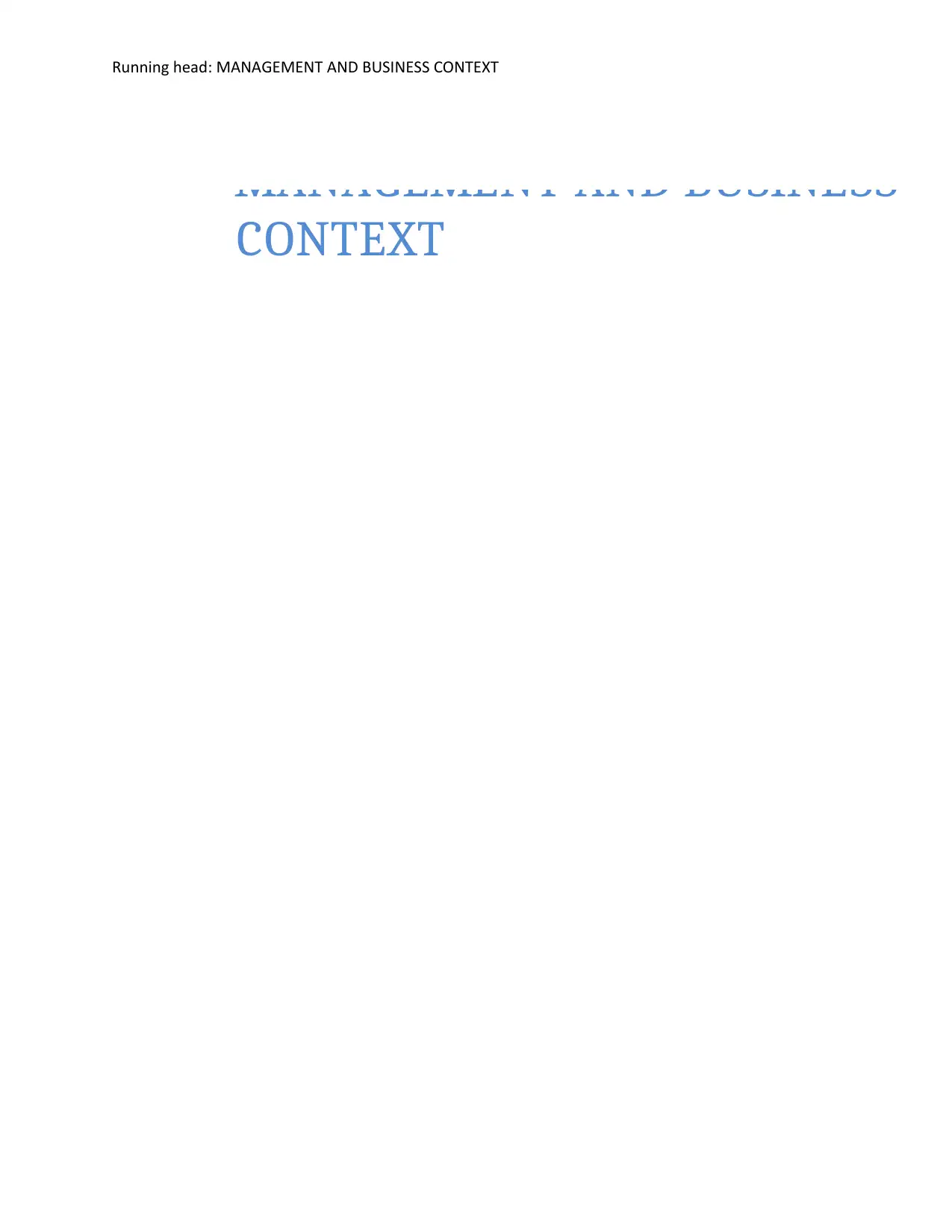
Running head: MANAGEMENT AND BUSINESS CONTEXT
MANAGEMENT AND BUSINESS
CONTEXT
MANAGEMENT AND BUSINESS
CONTEXT
Paraphrase This Document
Need a fresh take? Get an instant paraphrase of this document with our AI Paraphraser
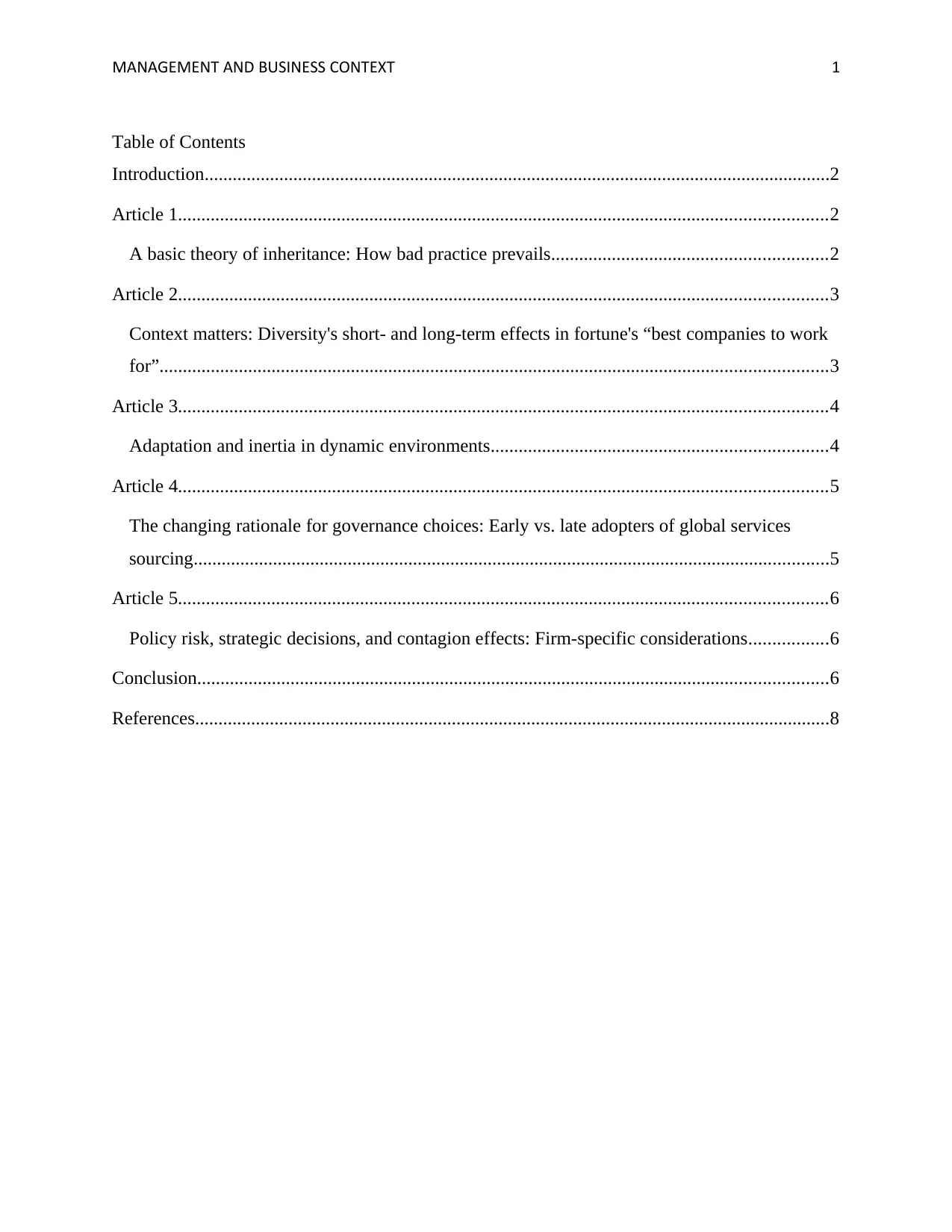
MANAGEMENT AND BUSINESS CONTEXT 1
Table of Contents
Introduction......................................................................................................................................2
Article 1...........................................................................................................................................2
A basic theory of inheritance: How bad practice prevails...........................................................2
Article 2...........................................................................................................................................3
Context matters: Diversity's short‐ and long‐term effects in fortune's “best companies to work
for”...............................................................................................................................................3
Article 3...........................................................................................................................................4
Adaptation and inertia in dynamic environments........................................................................4
Article 4...........................................................................................................................................5
The changing rationale for governance choices: Early vs. late adopters of global services
sourcing........................................................................................................................................5
Article 5...........................................................................................................................................6
Policy risk, strategic decisions, and contagion effects: Firm‐specific considerations.................6
Conclusion.......................................................................................................................................6
References........................................................................................................................................8
Table of Contents
Introduction......................................................................................................................................2
Article 1...........................................................................................................................................2
A basic theory of inheritance: How bad practice prevails...........................................................2
Article 2...........................................................................................................................................3
Context matters: Diversity's short‐ and long‐term effects in fortune's “best companies to work
for”...............................................................................................................................................3
Article 3...........................................................................................................................................4
Adaptation and inertia in dynamic environments........................................................................4
Article 4...........................................................................................................................................5
The changing rationale for governance choices: Early vs. late adopters of global services
sourcing........................................................................................................................................5
Article 5...........................................................................................................................................6
Policy risk, strategic decisions, and contagion effects: Firm‐specific considerations.................6
Conclusion.......................................................................................................................................6
References........................................................................................................................................8
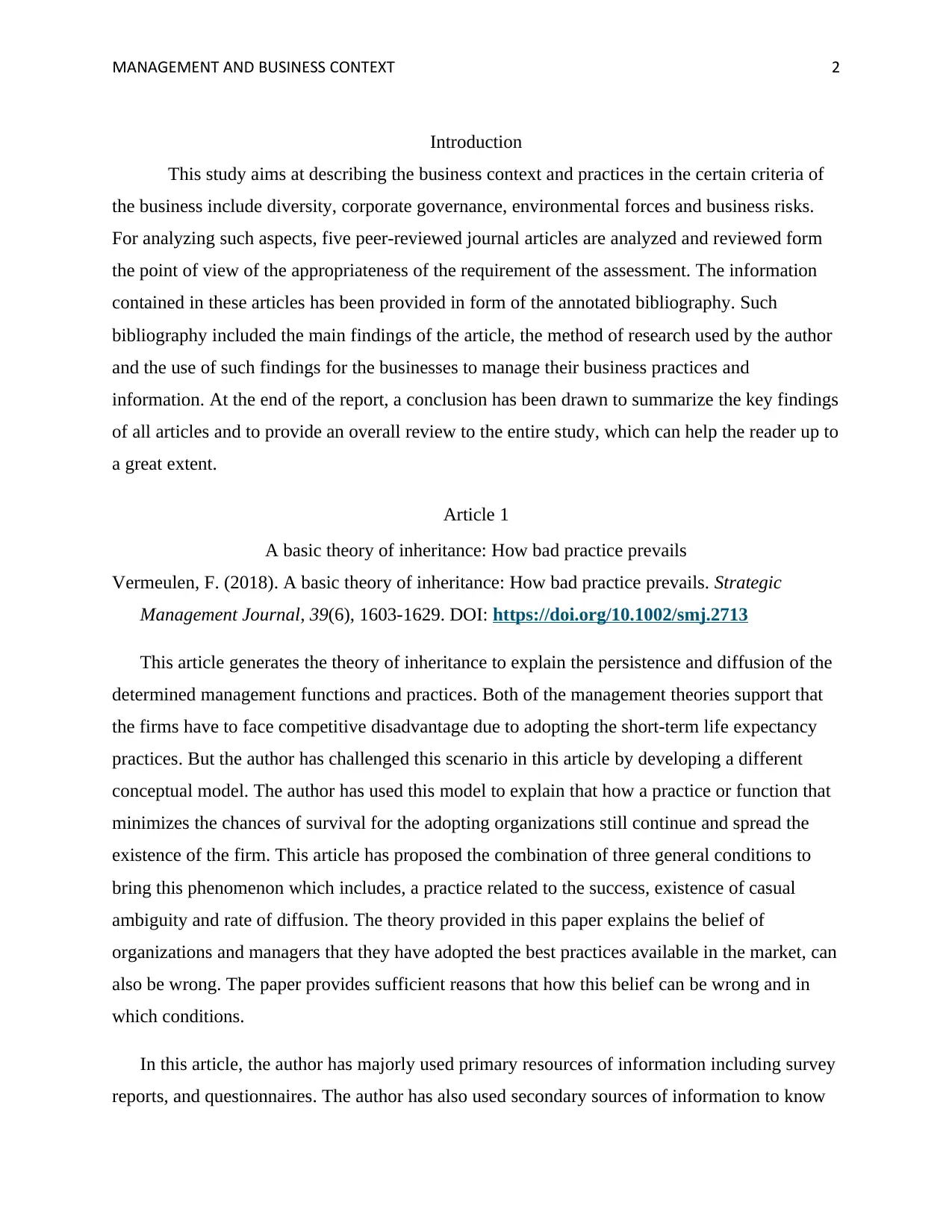
MANAGEMENT AND BUSINESS CONTEXT 2
Introduction
This study aims at describing the business context and practices in the certain criteria of
the business include diversity, corporate governance, environmental forces and business risks.
For analyzing such aspects, five peer-reviewed journal articles are analyzed and reviewed form
the point of view of the appropriateness of the requirement of the assessment. The information
contained in these articles has been provided in form of the annotated bibliography. Such
bibliography included the main findings of the article, the method of research used by the author
and the use of such findings for the businesses to manage their business practices and
information. At the end of the report, a conclusion has been drawn to summarize the key findings
of all articles and to provide an overall review to the entire study, which can help the reader up to
a great extent.
Article 1
A basic theory of inheritance: How bad practice prevails
Vermeulen, F. (2018). A basic theory of inheritance: How bad practice prevails. Strategic
Management Journal, 39(6), 1603-1629. DOI: https://doi.org/10.1002/smj.2713
This article generates the theory of inheritance to explain the persistence and diffusion of the
determined management functions and practices. Both of the management theories support that
the firms have to face competitive disadvantage due to adopting the short-term life expectancy
practices. But the author has challenged this scenario in this article by developing a different
conceptual model. The author has used this model to explain that how a practice or function that
minimizes the chances of survival for the adopting organizations still continue and spread the
existence of the firm. This article has proposed the combination of three general conditions to
bring this phenomenon which includes, a practice related to the success, existence of casual
ambiguity and rate of diffusion. The theory provided in this paper explains the belief of
organizations and managers that they have adopted the best practices available in the market, can
also be wrong. The paper provides sufficient reasons that how this belief can be wrong and in
which conditions.
In this article, the author has majorly used primary resources of information including survey
reports, and questionnaires. The author has also used secondary sources of information to know
Introduction
This study aims at describing the business context and practices in the certain criteria of
the business include diversity, corporate governance, environmental forces and business risks.
For analyzing such aspects, five peer-reviewed journal articles are analyzed and reviewed form
the point of view of the appropriateness of the requirement of the assessment. The information
contained in these articles has been provided in form of the annotated bibliography. Such
bibliography included the main findings of the article, the method of research used by the author
and the use of such findings for the businesses to manage their business practices and
information. At the end of the report, a conclusion has been drawn to summarize the key findings
of all articles and to provide an overall review to the entire study, which can help the reader up to
a great extent.
Article 1
A basic theory of inheritance: How bad practice prevails
Vermeulen, F. (2018). A basic theory of inheritance: How bad practice prevails. Strategic
Management Journal, 39(6), 1603-1629. DOI: https://doi.org/10.1002/smj.2713
This article generates the theory of inheritance to explain the persistence and diffusion of the
determined management functions and practices. Both of the management theories support that
the firms have to face competitive disadvantage due to adopting the short-term life expectancy
practices. But the author has challenged this scenario in this article by developing a different
conceptual model. The author has used this model to explain that how a practice or function that
minimizes the chances of survival for the adopting organizations still continue and spread the
existence of the firm. This article has proposed the combination of three general conditions to
bring this phenomenon which includes, a practice related to the success, existence of casual
ambiguity and rate of diffusion. The theory provided in this paper explains the belief of
organizations and managers that they have adopted the best practices available in the market, can
also be wrong. The paper provides sufficient reasons that how this belief can be wrong and in
which conditions.
In this article, the author has majorly used primary resources of information including survey
reports, and questionnaires. The author has also used secondary sources of information to know
⊘ This is a preview!⊘
Do you want full access?
Subscribe today to unlock all pages.

Trusted by 1+ million students worldwide
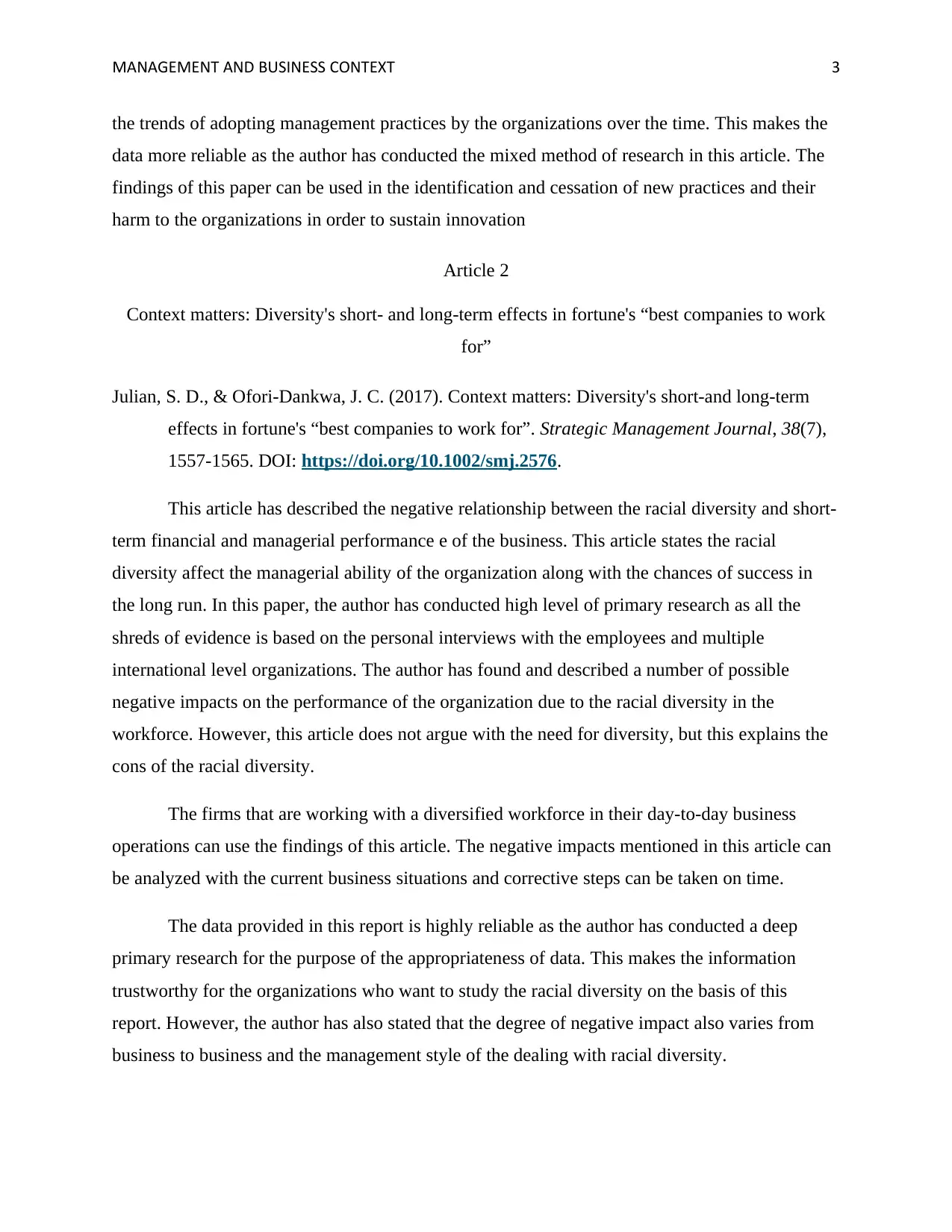
MANAGEMENT AND BUSINESS CONTEXT 3
the trends of adopting management practices by the organizations over the time. This makes the
data more reliable as the author has conducted the mixed method of research in this article. The
findings of this paper can be used in the identification and cessation of new practices and their
harm to the organizations in order to sustain innovation
Article 2
Context matters: Diversity's short‐ and long‐term effects in fortune's “best companies to work
for”
Julian, S. D., & Ofori‐Dankwa, J. C. (2017). Context matters: Diversity's short‐and long‐term
effects in fortune's “best companies to work for”. Strategic Management Journal, 38(7),
1557-1565. DOI: https://doi.org/10.1002/smj.2576.
This article has described the negative relationship between the racial diversity and short-
term financial and managerial performance e of the business. This article states the racial
diversity affect the managerial ability of the organization along with the chances of success in
the long run. In this paper, the author has conducted high level of primary research as all the
shreds of evidence is based on the personal interviews with the employees and multiple
international level organizations. The author has found and described a number of possible
negative impacts on the performance of the organization due to the racial diversity in the
workforce. However, this article does not argue with the need for diversity, but this explains the
cons of the racial diversity.
The firms that are working with a diversified workforce in their day-to-day business
operations can use the findings of this article. The negative impacts mentioned in this article can
be analyzed with the current business situations and corrective steps can be taken on time.
The data provided in this report is highly reliable as the author has conducted a deep
primary research for the purpose of the appropriateness of data. This makes the information
trustworthy for the organizations who want to study the racial diversity on the basis of this
report. However, the author has also stated that the degree of negative impact also varies from
business to business and the management style of the dealing with racial diversity.
the trends of adopting management practices by the organizations over the time. This makes the
data more reliable as the author has conducted the mixed method of research in this article. The
findings of this paper can be used in the identification and cessation of new practices and their
harm to the organizations in order to sustain innovation
Article 2
Context matters: Diversity's short‐ and long‐term effects in fortune's “best companies to work
for”
Julian, S. D., & Ofori‐Dankwa, J. C. (2017). Context matters: Diversity's short‐and long‐term
effects in fortune's “best companies to work for”. Strategic Management Journal, 38(7),
1557-1565. DOI: https://doi.org/10.1002/smj.2576.
This article has described the negative relationship between the racial diversity and short-
term financial and managerial performance e of the business. This article states the racial
diversity affect the managerial ability of the organization along with the chances of success in
the long run. In this paper, the author has conducted high level of primary research as all the
shreds of evidence is based on the personal interviews with the employees and multiple
international level organizations. The author has found and described a number of possible
negative impacts on the performance of the organization due to the racial diversity in the
workforce. However, this article does not argue with the need for diversity, but this explains the
cons of the racial diversity.
The firms that are working with a diversified workforce in their day-to-day business
operations can use the findings of this article. The negative impacts mentioned in this article can
be analyzed with the current business situations and corrective steps can be taken on time.
The data provided in this report is highly reliable as the author has conducted a deep
primary research for the purpose of the appropriateness of data. This makes the information
trustworthy for the organizations who want to study the racial diversity on the basis of this
report. However, the author has also stated that the degree of negative impact also varies from
business to business and the management style of the dealing with racial diversity.
Paraphrase This Document
Need a fresh take? Get an instant paraphrase of this document with our AI Paraphraser
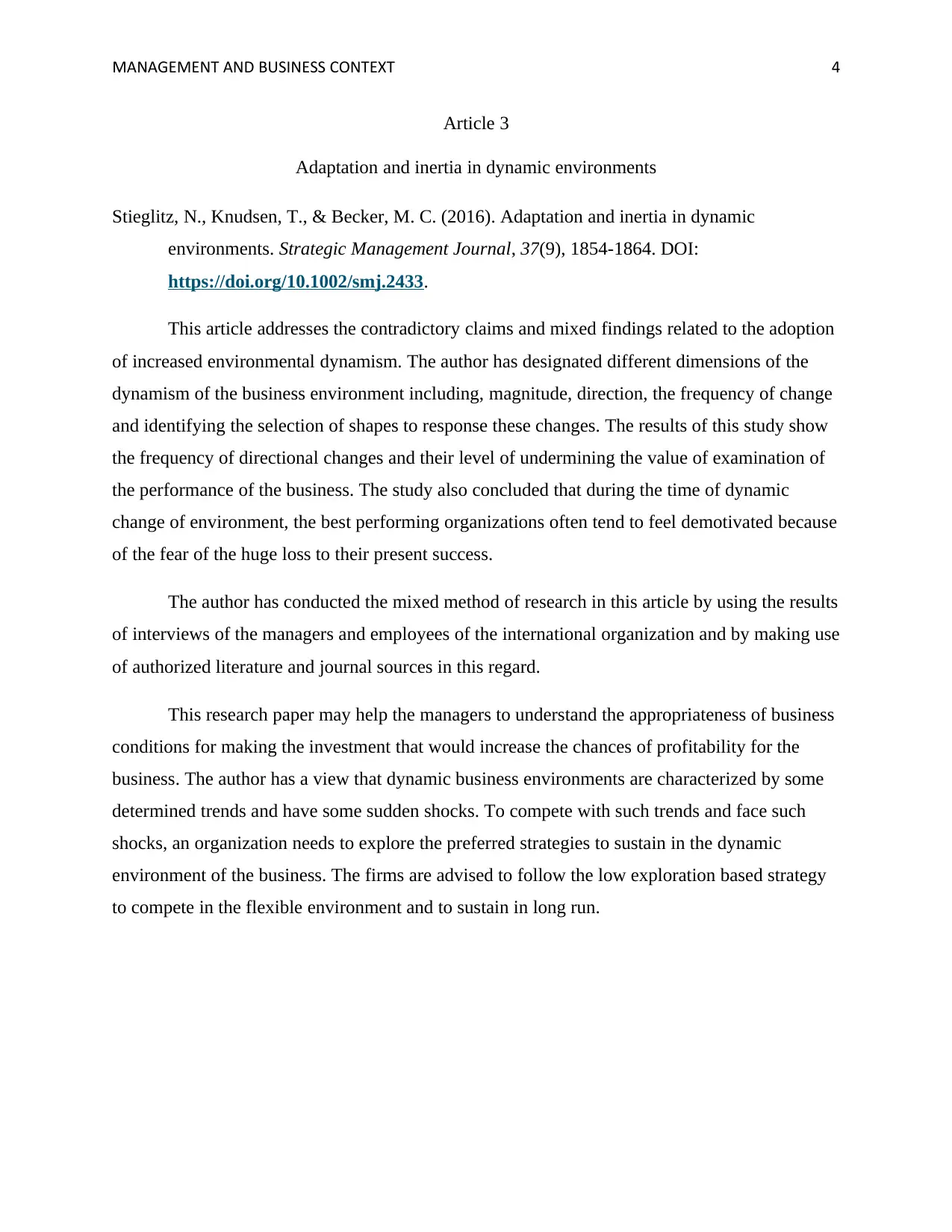
MANAGEMENT AND BUSINESS CONTEXT 4
Article 3
Adaptation and inertia in dynamic environments
Stieglitz, N., Knudsen, T., & Becker, M. C. (2016). Adaptation and inertia in dynamic
environments. Strategic Management Journal, 37(9), 1854-1864. DOI:
https://doi.org/10.1002/smj.2433.
This article addresses the contradictory claims and mixed findings related to the adoption
of increased environmental dynamism. The author has designated different dimensions of the
dynamism of the business environment including, magnitude, direction, the frequency of change
and identifying the selection of shapes to response these changes. The results of this study show
the frequency of directional changes and their level of undermining the value of examination of
the performance of the business. The study also concluded that during the time of dynamic
change of environment, the best performing organizations often tend to feel demotivated because
of the fear of the huge loss to their present success.
The author has conducted the mixed method of research in this article by using the results
of interviews of the managers and employees of the international organization and by making use
of authorized literature and journal sources in this regard.
This research paper may help the managers to understand the appropriateness of business
conditions for making the investment that would increase the chances of profitability for the
business. The author has a view that dynamic business environments are characterized by some
determined trends and have some sudden shocks. To compete with such trends and face such
shocks, an organization needs to explore the preferred strategies to sustain in the dynamic
environment of the business. The firms are advised to follow the low exploration based strategy
to compete in the flexible environment and to sustain in long run.
Article 3
Adaptation and inertia in dynamic environments
Stieglitz, N., Knudsen, T., & Becker, M. C. (2016). Adaptation and inertia in dynamic
environments. Strategic Management Journal, 37(9), 1854-1864. DOI:
https://doi.org/10.1002/smj.2433.
This article addresses the contradictory claims and mixed findings related to the adoption
of increased environmental dynamism. The author has designated different dimensions of the
dynamism of the business environment including, magnitude, direction, the frequency of change
and identifying the selection of shapes to response these changes. The results of this study show
the frequency of directional changes and their level of undermining the value of examination of
the performance of the business. The study also concluded that during the time of dynamic
change of environment, the best performing organizations often tend to feel demotivated because
of the fear of the huge loss to their present success.
The author has conducted the mixed method of research in this article by using the results
of interviews of the managers and employees of the international organization and by making use
of authorized literature and journal sources in this regard.
This research paper may help the managers to understand the appropriateness of business
conditions for making the investment that would increase the chances of profitability for the
business. The author has a view that dynamic business environments are characterized by some
determined trends and have some sudden shocks. To compete with such trends and face such
shocks, an organization needs to explore the preferred strategies to sustain in the dynamic
environment of the business. The firms are advised to follow the low exploration based strategy
to compete in the flexible environment and to sustain in long run.
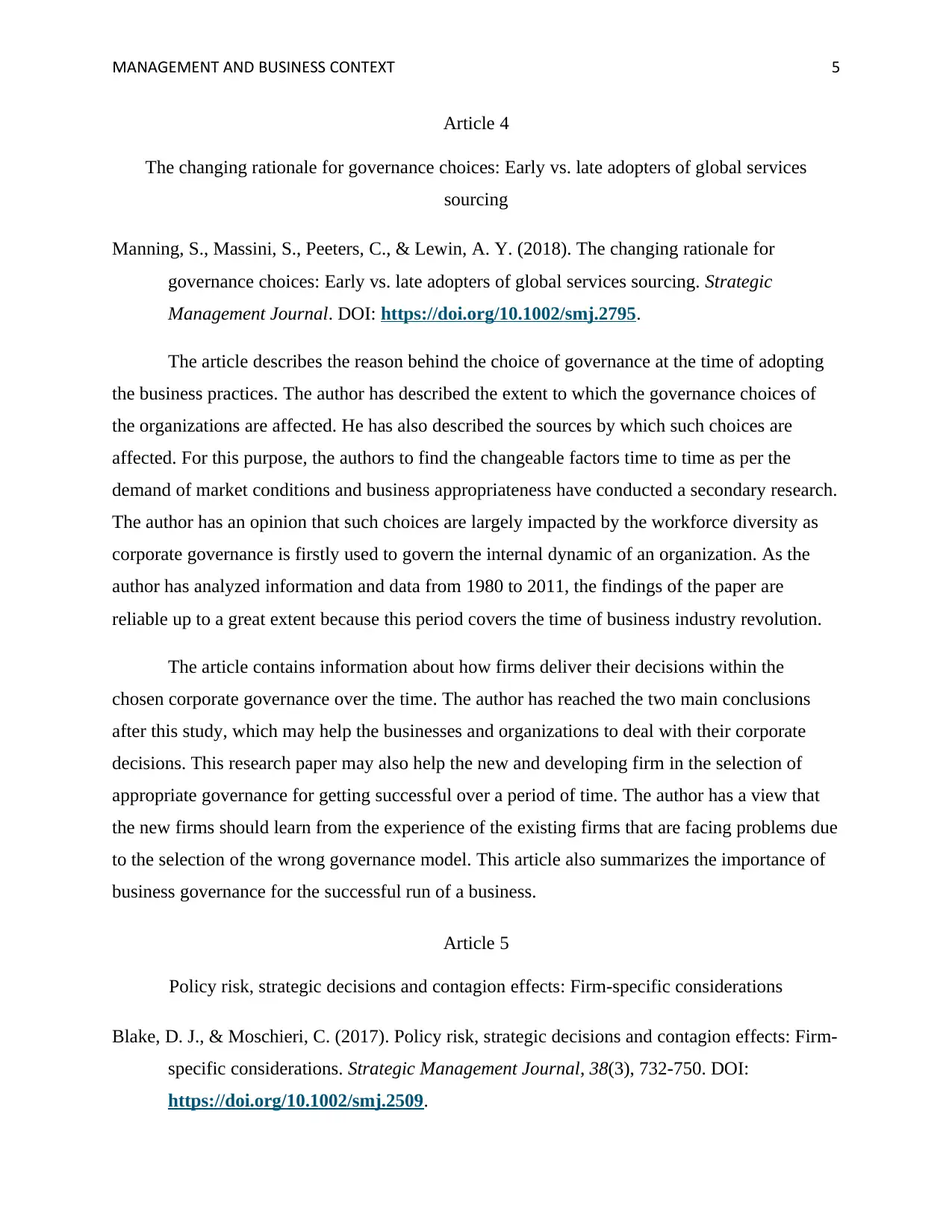
MANAGEMENT AND BUSINESS CONTEXT 5
Article 4
The changing rationale for governance choices: Early vs. late adopters of global services
sourcing
Manning, S., Massini, S., Peeters, C., & Lewin, A. Y. (2018). The changing rationale for
governance choices: Early vs. late adopters of global services sourcing. Strategic
Management Journal. DOI: https://doi.org/10.1002/smj.2795.
The article describes the reason behind the choice of governance at the time of adopting
the business practices. The author has described the extent to which the governance choices of
the organizations are affected. He has also described the sources by which such choices are
affected. For this purpose, the authors to find the changeable factors time to time as per the
demand of market conditions and business appropriateness have conducted a secondary research.
The author has an opinion that such choices are largely impacted by the workforce diversity as
corporate governance is firstly used to govern the internal dynamic of an organization. As the
author has analyzed information and data from 1980 to 2011, the findings of the paper are
reliable up to a great extent because this period covers the time of business industry revolution.
The article contains information about how firms deliver their decisions within the
chosen corporate governance over the time. The author has reached the two main conclusions
after this study, which may help the businesses and organizations to deal with their corporate
decisions. This research paper may also help the new and developing firm in the selection of
appropriate governance for getting successful over a period of time. The author has a view that
the new firms should learn from the experience of the existing firms that are facing problems due
to the selection of the wrong governance model. This article also summarizes the importance of
business governance for the successful run of a business.
Article 5
Policy risk, strategic decisions and contagion effects: Firm‐specific considerations
Blake, D. J., & Moschieri, C. (2017). Policy risk, strategic decisions and contagion effects: Firm‐
specific considerations. Strategic Management Journal, 38(3), 732-750. DOI:
https://doi.org/10.1002/smj.2509.
Article 4
The changing rationale for governance choices: Early vs. late adopters of global services
sourcing
Manning, S., Massini, S., Peeters, C., & Lewin, A. Y. (2018). The changing rationale for
governance choices: Early vs. late adopters of global services sourcing. Strategic
Management Journal. DOI: https://doi.org/10.1002/smj.2795.
The article describes the reason behind the choice of governance at the time of adopting
the business practices. The author has described the extent to which the governance choices of
the organizations are affected. He has also described the sources by which such choices are
affected. For this purpose, the authors to find the changeable factors time to time as per the
demand of market conditions and business appropriateness have conducted a secondary research.
The author has an opinion that such choices are largely impacted by the workforce diversity as
corporate governance is firstly used to govern the internal dynamic of an organization. As the
author has analyzed information and data from 1980 to 2011, the findings of the paper are
reliable up to a great extent because this period covers the time of business industry revolution.
The article contains information about how firms deliver their decisions within the
chosen corporate governance over the time. The author has reached the two main conclusions
after this study, which may help the businesses and organizations to deal with their corporate
decisions. This research paper may also help the new and developing firm in the selection of
appropriate governance for getting successful over a period of time. The author has a view that
the new firms should learn from the experience of the existing firms that are facing problems due
to the selection of the wrong governance model. This article also summarizes the importance of
business governance for the successful run of a business.
Article 5
Policy risk, strategic decisions and contagion effects: Firm‐specific considerations
Blake, D. J., & Moschieri, C. (2017). Policy risk, strategic decisions and contagion effects: Firm‐
specific considerations. Strategic Management Journal, 38(3), 732-750. DOI:
https://doi.org/10.1002/smj.2509.
⊘ This is a preview!⊘
Do you want full access?
Subscribe today to unlock all pages.

Trusted by 1+ million students worldwide
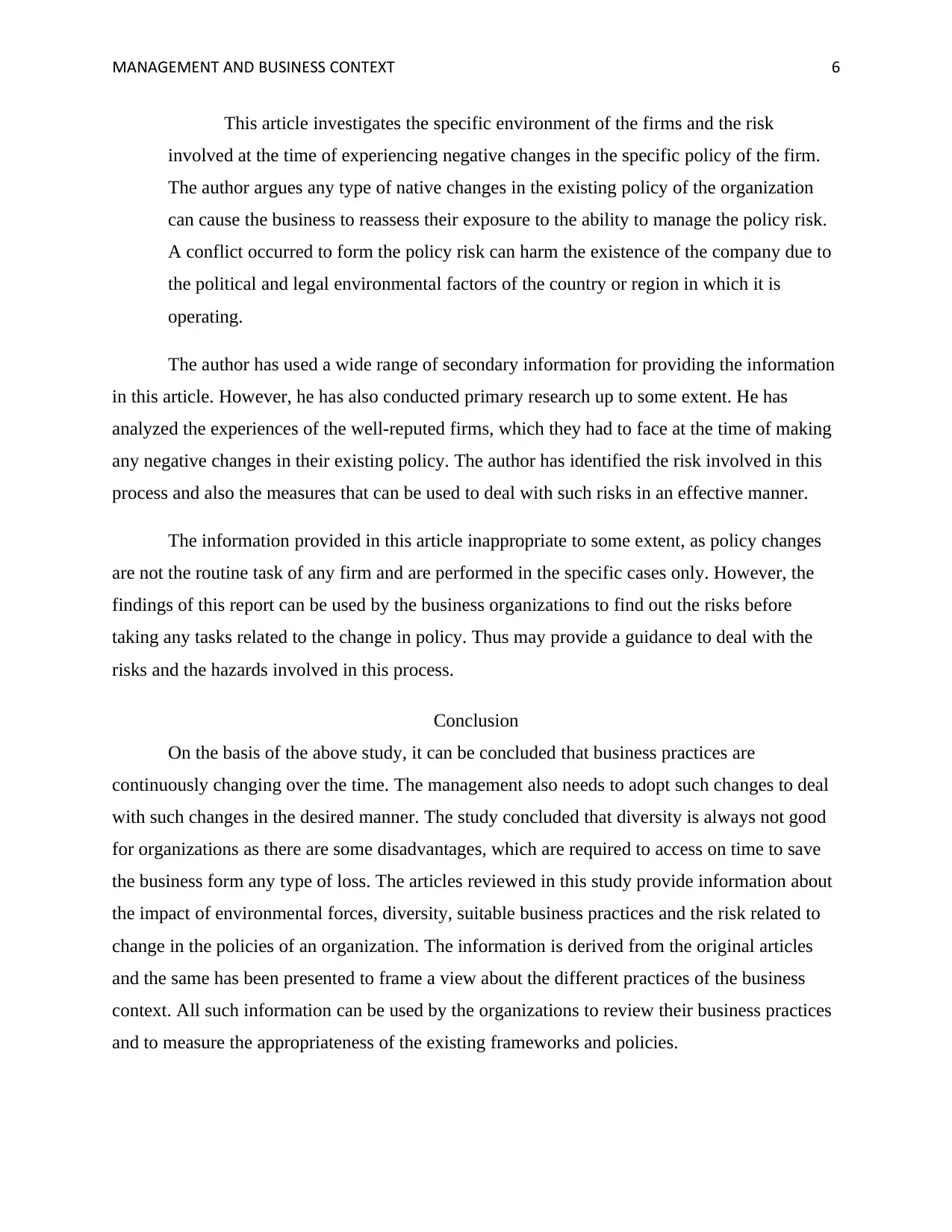
MANAGEMENT AND BUSINESS CONTEXT 6
This article investigates the specific environment of the firms and the risk
involved at the time of experiencing negative changes in the specific policy of the firm.
The author argues any type of native changes in the existing policy of the organization
can cause the business to reassess their exposure to the ability to manage the policy risk.
A conflict occurred to form the policy risk can harm the existence of the company due to
the political and legal environmental factors of the country or region in which it is
operating.
The author has used a wide range of secondary information for providing the information
in this article. However, he has also conducted primary research up to some extent. He has
analyzed the experiences of the well-reputed firms, which they had to face at the time of making
any negative changes in their existing policy. The author has identified the risk involved in this
process and also the measures that can be used to deal with such risks in an effective manner.
The information provided in this article inappropriate to some extent, as policy changes
are not the routine task of any firm and are performed in the specific cases only. However, the
findings of this report can be used by the business organizations to find out the risks before
taking any tasks related to the change in policy. Thus may provide a guidance to deal with the
risks and the hazards involved in this process.
Conclusion
On the basis of the above study, it can be concluded that business practices are
continuously changing over the time. The management also needs to adopt such changes to deal
with such changes in the desired manner. The study concluded that diversity is always not good
for organizations as there are some disadvantages, which are required to access on time to save
the business form any type of loss. The articles reviewed in this study provide information about
the impact of environmental forces, diversity, suitable business practices and the risk related to
change in the policies of an organization. The information is derived from the original articles
and the same has been presented to frame a view about the different practices of the business
context. All such information can be used by the organizations to review their business practices
and to measure the appropriateness of the existing frameworks and policies.
This article investigates the specific environment of the firms and the risk
involved at the time of experiencing negative changes in the specific policy of the firm.
The author argues any type of native changes in the existing policy of the organization
can cause the business to reassess their exposure to the ability to manage the policy risk.
A conflict occurred to form the policy risk can harm the existence of the company due to
the political and legal environmental factors of the country or region in which it is
operating.
The author has used a wide range of secondary information for providing the information
in this article. However, he has also conducted primary research up to some extent. He has
analyzed the experiences of the well-reputed firms, which they had to face at the time of making
any negative changes in their existing policy. The author has identified the risk involved in this
process and also the measures that can be used to deal with such risks in an effective manner.
The information provided in this article inappropriate to some extent, as policy changes
are not the routine task of any firm and are performed in the specific cases only. However, the
findings of this report can be used by the business organizations to find out the risks before
taking any tasks related to the change in policy. Thus may provide a guidance to deal with the
risks and the hazards involved in this process.
Conclusion
On the basis of the above study, it can be concluded that business practices are
continuously changing over the time. The management also needs to adopt such changes to deal
with such changes in the desired manner. The study concluded that diversity is always not good
for organizations as there are some disadvantages, which are required to access on time to save
the business form any type of loss. The articles reviewed in this study provide information about
the impact of environmental forces, diversity, suitable business practices and the risk related to
change in the policies of an organization. The information is derived from the original articles
and the same has been presented to frame a view about the different practices of the business
context. All such information can be used by the organizations to review their business practices
and to measure the appropriateness of the existing frameworks and policies.
Paraphrase This Document
Need a fresh take? Get an instant paraphrase of this document with our AI Paraphraser
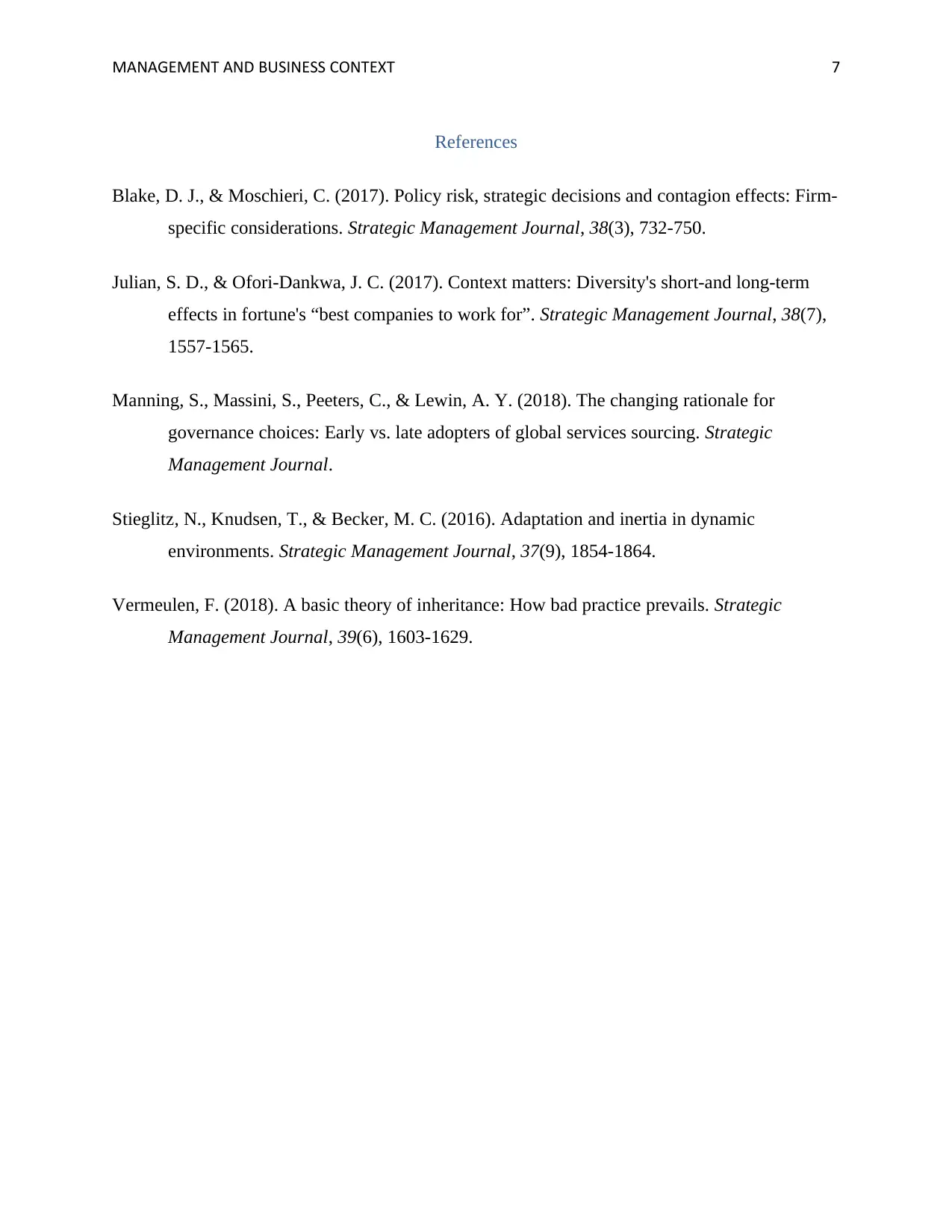
MANAGEMENT AND BUSINESS CONTEXT 7
References
Blake, D. J., & Moschieri, C. (2017). Policy risk, strategic decisions and contagion effects: Firm‐
specific considerations. Strategic Management Journal, 38(3), 732-750.
Julian, S. D., & Ofori‐Dankwa, J. C. (2017). Context matters: Diversity's short‐and long‐term
effects in fortune's “best companies to work for”. Strategic Management Journal, 38(7),
1557-1565.
Manning, S., Massini, S., Peeters, C., & Lewin, A. Y. (2018). The changing rationale for
governance choices: Early vs. late adopters of global services sourcing. Strategic
Management Journal.
Stieglitz, N., Knudsen, T., & Becker, M. C. (2016). Adaptation and inertia in dynamic
environments. Strategic Management Journal, 37(9), 1854-1864.
Vermeulen, F. (2018). A basic theory of inheritance: How bad practice prevails. Strategic
Management Journal, 39(6), 1603-1629.
References
Blake, D. J., & Moschieri, C. (2017). Policy risk, strategic decisions and contagion effects: Firm‐
specific considerations. Strategic Management Journal, 38(3), 732-750.
Julian, S. D., & Ofori‐Dankwa, J. C. (2017). Context matters: Diversity's short‐and long‐term
effects in fortune's “best companies to work for”. Strategic Management Journal, 38(7),
1557-1565.
Manning, S., Massini, S., Peeters, C., & Lewin, A. Y. (2018). The changing rationale for
governance choices: Early vs. late adopters of global services sourcing. Strategic
Management Journal.
Stieglitz, N., Knudsen, T., & Becker, M. C. (2016). Adaptation and inertia in dynamic
environments. Strategic Management Journal, 37(9), 1854-1864.
Vermeulen, F. (2018). A basic theory of inheritance: How bad practice prevails. Strategic
Management Journal, 39(6), 1603-1629.
1 out of 8
Related Documents
Your All-in-One AI-Powered Toolkit for Academic Success.
+13062052269
info@desklib.com
Available 24*7 on WhatsApp / Email
![[object Object]](/_next/static/media/star-bottom.7253800d.svg)
Unlock your academic potential
Copyright © 2020–2025 A2Z Services. All Rights Reserved. Developed and managed by ZUCOL.




